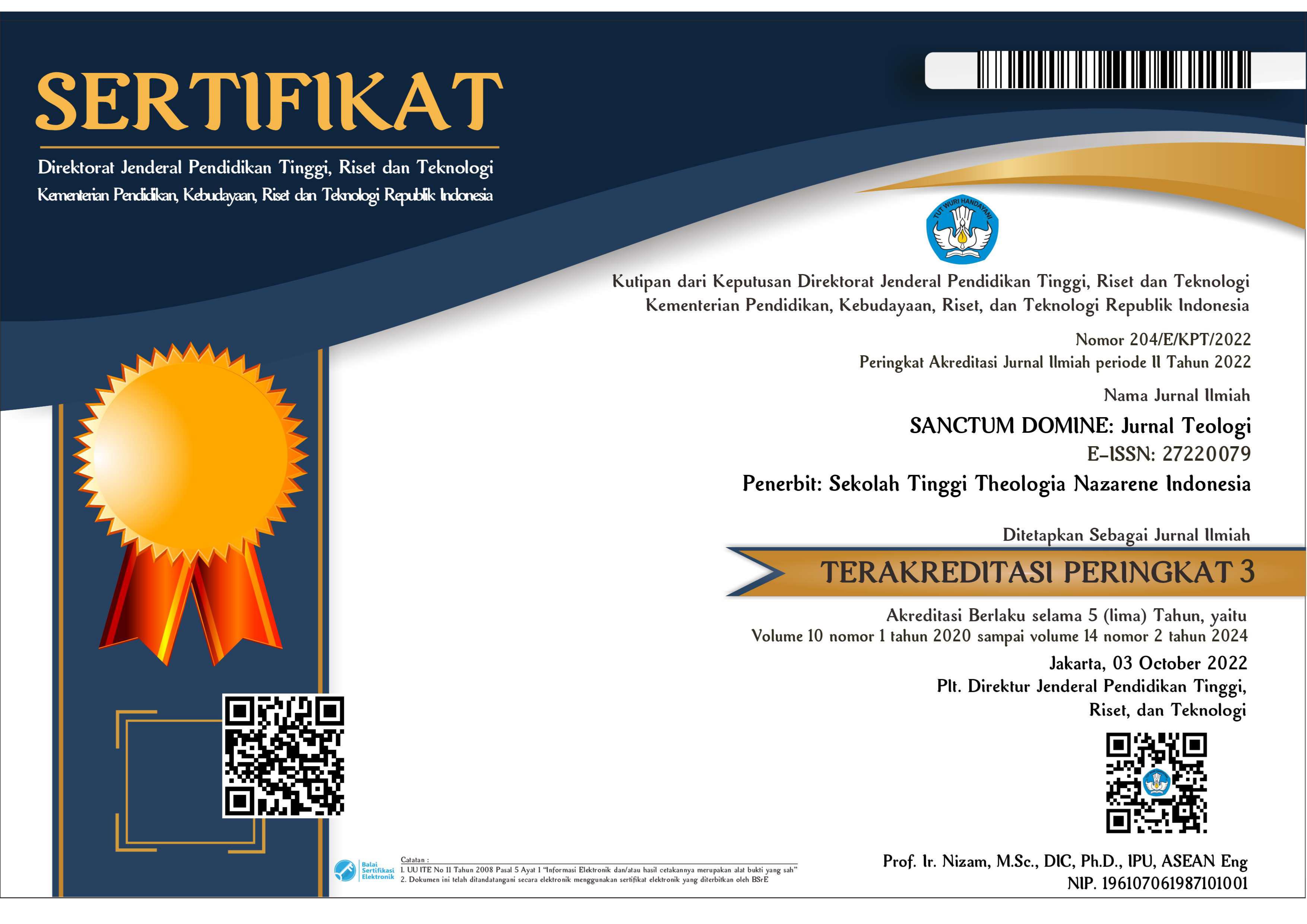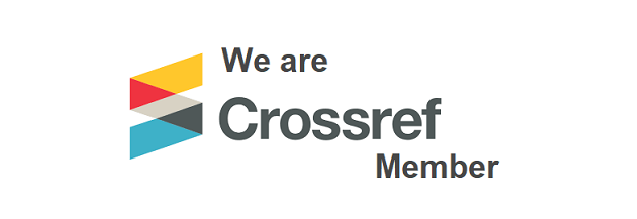The Contribution of Christian Religious Education Teachers in Nurturing Confidence of Students with Disabilities
Abstract
The background of this paper was based on the fact that the contribution of teachers in helping to increase the confidence of students with disabilities had not been significant. The real contribution as a teacher was very necessary, considering that the students who were categorized as disabled in 2020-2021 had reached 144,621 students. The size of students with disabilities was a concern for every one of us, especially teachers, to help educationally and mentally. In describing this paper, the researchers used qualitative methods with a literature study approach. The formulation of questions to be answered in this article, what was the description of the problems of students with disabilities? What was the concrete contribution of PAK teachers in fostering the confidence of these students? The results of the discussion in this article suggested that the problems experienced by students with disabilities were that they received a negative stigma and were vulnerable to mental health.The teachers’ real contribution to help the growth of the students’ self-confidence was carried out through a friendship-based teaching approach, skill-based education and independence-based education. The students' confidence would grow if this was realized and the educators followed Jesus' attitude in humanizing disabled people.
References
Afifah, Wiwik, and Syofyan Hadi. “Hak Pendidikan Penyandang Distabilitas Di Jawa Timur.” DiH: Jurnal Ilmu Hukum 14, no. 28 (2018): 370101. http://jurnal.untag-sby.ac.id/index.php/dih/article/view/1793.
Alfina, Alisa. “Guru Humanis Pendidikan Anak Usia Dini (PAUD).” Jurnal CARE (Children Advisory Research and Education) 3, no. 3 (2016): 58–66. http://e-journal.unipma.ac.id/index.php/JPAUD/article/view/611.
Anzari, Mudhafar, A Hamid Sarong, and M Nur Rasyid. “Hak Memperoleh Pendidikan Inklusif Terhadap Penyandang Distabilitas.” Syiah Kuala Law Journal 2, no. 1 (2018): 57–73. https://jurnal.unsyiah.ac.id/SKLJ/article/view/10586.
Benawa, Arcadius. “Sikap Respek Yesus Terhadap Penyandang Distabilitas.” International Journal of Disabilities and Social Inclusion 2, no. 01 (2022): 35–40. https://www.ijodasi.org/index.php/ijodasi/article/view/23.
Christiana, Esther. “Pendidikan Yang Memanusiakan Manusia.” Humaniora 4, no. 1 (2013): 398–410. https://journal.binus.ac.id/index.php/Humaniora/article/view/3450.
Cook, Michael J. “Rabbinic Judaism and Early Christianity: From the Pharisees to the Rabbis.” Review & Expositor 84, no. 2 (1987): 201–220.
Darius, Darius, and Filia Amelia Kasinda. “Solidaritas Yesus Terhadap Distabilitas: Suatu Implikasi Praktis Solidaritas Gereja Terhadap Kaum Distabilitas.” SANCTUM DOMINE: JURNAL TEOLOGI 12, no. 1 (2022): 35–48. https://journal.sttni.ac.id/index.php/SDJT/article/view/136.
GINTING, MARCELINA TERESIA, and others. “Diskriminasi Kaum Disabel Dalam Menempuh Pendidikan Tinggi.” Universitas Narotama, 2017.
Goa, Lorentius. “EFEKTIFITAS PAGUYUBAN ORANG TUA DALAM PEMBERDAYAAN ANAK DISTABILITAS DI MOJOREJO BLITAR.” SAPA-Jurnal Kateketik dan Pastoral 4, no. 2 (2019): 86–106. https://e-journal.stp-ipi.ac.id/index.php/sapa/article/view/81.
Humairah, Nurfadila, Syahrul Alim, and others. “Kepercayaan Diri Dan Penyesuaian Diri Sebagai Prediktor Penerimaan Diri Pada Penyandang Distabilitas.” Jurnal Psikologi Karakter 1, no. 2 (2021): 139–146. https://journal.unibos.ac.id/jpk/article/view/1226.
Husain, Hernawati, Lena Anjarsari Sembiring, and Simon Simon. “Menerapkan Pola Pendidikan Perjanjian Baru Pada Pendidikan Kristiani Masa Kini.” REGULA FIDEI: Jurnal Pendidikan Agama Kristen 6, no. 2 (2021).
Lestari, Dian, and Wirdanengsih Wirdanengsih. “Stereotipe Terhadap Perempuan Penyandang Distabilitas Di Kota Padang (Studi Pada Perempuan Penyandang Distabilitas Daksa Di DPC PPDI Kota Padang).” Jurnal Perspektif 3, no. 2 (2020): 262–271. http://perspektif.ppj.unp.ac.id/index.php/perspektif/article/view/249.
Maftuhin, Arif. “Mengikat Makna Diskriminasi: Penyandang Cacat, Difabel, Dan Penyandang Distabilitas.” INKLUSI: Journal of Disability Studies 3, no. 2 (2016): 139–162. https://ejournal.uin-suka.ac.id/pusat/inklusi/article/view/030201.
Mallisa, Ricky. “Pendidikan Agama Kristen Yang Terintegrasi Terhadap Pembentukan Karakter Dan Mental Penyandang Distabilitas” 2, no. 1 (2021): 1–14. https://peada.iakn-toraja.ac.id/index.php/ojsdatapeada/article/view/26.
Mardiyati, Ani, and others. “Peran Pendamping Berbasis Masyarakat Bagi Penyandang Distabilitas Dalam Membangun Kemandirian.” Media Informasi Penelitian Kesejahteraan Sosial 41, no. 2 (2017): 133–144. https://ejournal.kemensos.go.id/index.php/mediainformasi/article/view/2265.
Mauleky, Amus. “Manajemen Kurikulum Pendidikan Agama Kristen Dalam Gereja Bagi Distabilitas.” Jurnal Ilmiah Religiosity Entity Humanity (JIREH) 4, no. 1 (2022): 95–103. https://ojs-jireh.org/index.php/jireh/article/view/90.
Mursid, R. “Pengembangan Model Pembelajaran Praktik Berbasis Kompetensi Berorientasi Produksi.” Jurnal Cakrawala Pendidikan 5, no. 1 (2013). https://journal.uny.ac.id/index.php/cp/article/view/1257.
Negara, I G N Made Kusuma Negara Kusuma, I Putu Agus Endra Susanta, and others. “KEMANDIRIAN PERSONAL HYGIENE PADA DISTABILITAS DI SLB D YPAC BALI.” Jurnal RIset Kesehatan Nasional 6, no. 1 (2022): 31–35. https://ejournal.itekes-bali.ac.id/jrkn/article/view/345.
Priamsari, R R Putri A. “Hukum Yang Berkeadilan Bagi Penyandang Distabilitas.” Masalah-Masalah Hukum 48, no. 2 (2019): 215–223. https://ejournal.undip.ac.id/index.php/mmh/article/view/21176.
Rochayati, Nurin, Siti Sanisah, and others. “PERSEPSI GURU TENTANG PENDIDIKAN BAGI PENYENDANG DISTABILITAS.” GEOGRAPHY: Jurnal Kajian, Penelitian dan Pengembangan Pendidikan 10, no. 1 (2022): 92–104. http://journal.ummat.ac.id/index.php/geography/article/view/8279.
Salirawati, Das. “Percaya Diri, Keingintahuan, Dan Berjiwa Wirausaha: Tiga Karakter Penting Bagi Peserta Didik.” Jurnal Pendidikan Karakter 3, no. 2 (2012): 213–224. https://journal.uny.ac.id/index.php/jpka/article/view/1305.
Sembiring, Lena Anjarsari, and Simon Simon. “Kontribusi Pengajar Pendidikan Agama Kristen Dalam Membantu Pemulihan Traumatis Korban Pelecahan Seksual.” Jurnal Shanan 6, no. 1 (2022): 25–44. http://ejournal.uki.ac.id/index.php/shan/article/view/3624.
———. “Menggagas Pembelajaran Agama Kristen Berbasis Misiologi.” Harati: Jurnal Pendidikan Kristen 2, no. 1 (2022): 32–45.
Sinaga, Solmeriana. “METODE PEMBELAJARAN PENDIDIKAN AGAMA KRISTEN (PAK) UNTUK KELOMPOK DISTABILITAS DI GEREJA HURIA KRISTEN INDONESIA (HKI) RESORT LUBUK PAKAM.” Regula Fidei: Jurnal Pendidikan Agama Kristen 4, no. 1 (2019): 70–91. http://christianeducation.id/e-journal/index.php/regulafidei/article/view/33.
Sinaulan, Nova Lisye, Ellen S Kambey, and Semuel Selanno. “Pembelajaran Pendidikan Agama Kristen Bagi Siswa Tunarungu Di Era New Normal.” Jurnal Ilmiah Wahana Pendidikan 7, no. 6 (2021): 75–89. http://jurnal.peneliti.net/index.php/JIWP/article/view/965.
Sixtus, Bernard. “Friendship: Exploring Its Implications for the Church in Postmodernity.” Ecclesiology 7, no. 1 (2011): 118–120. https://brill.com/view/journals/ecso/7/1/article-p118_14.xml.
Susanta, Yohanes Krismantyo. “‘Menjadi Sesama Manusia’ Persahabatan Sebagai Tema Teologis Dan Implikasinya Bagi Kehidupan Bergereja.” DUNAMIS: Jurnal Teologi dan Pendidikan Kristiani 2, no. 2 (2018): 103–118. https://www.sttintheos.ac.id/e-journal/index.php/dunamis/article/view/169.
Triadi, Rai Bagus, and Frilia Shantika Regina. “KESULITAN MENULIS PADA ANAK DISTABILITAS: STUDI KASUS ANAK GANGGUAN DISLEKSIA USIA 8 TAHUN” 5, no. 1 (2021): 167–179. https://jurnal.unma.ac.id/index.php/dl/article/view/2574.
Trisutomo, Niken Probondani Astuti, and Rizal Bakri. “Pengenalan Aplikasi Simulator Bank Berbasis Internet Pada Mahasiswa Penyandang Distabilitas.” Literasi: Jurnal Pengabdian Masyarakat dan Inovasi 2, no. 1 (2022): 446–452. https://jurnal.politap.ac.id/index.php/literasi/article/view/303.
Ulfa, Rosy Maria, Tontowi Jauhari, and Siti Bahiroh. “Pola Pembinaan Kepercayaan Diri Penyandang Distabilitas Daksa.” Bina’Al-Ummah 15, no. 1 (2020): 41–54. http://ejournal.radenintan.ac.id/index.php/alummah/article/view/6551.
Wahyuningsih, Sri, and Siti Umaeroh. “Penanaman Karakter Kemandirian Pada Anak Distabilitas Grahita Melalui Pembelajaran Tematik Di SDLB Kaliwungu Kudus.” Lectura: Jurnal Pendidikan 12, no. 2 (2021): 166–179. http://journal.unilak.ac.id/index.php/lectura/article/view/6323.
Widinarsih, Dini. “PENYANDANG DISTABILITAS DI INDONESIA: PERKEMBANGAN ISTILAH DAN DEFINISI.” Jurnal Ilmu Kesejahteraan Sosial 20, no. 2 (2019): 127–142.
Yasipin, Yasipin, Silvia Ayu Rianti, and Nurman Hidaya. “Peran Agama Dalam Membentuk Kesehatan Mental Remaja.” Manthiq 5, no. 1 (2020): 25–31. https://ejournal.iainbengkulu.ac.id/index.php/manthiq/article/view/3240.
Yosepha Pusparisa. “Pelajar SLB Indonesia Tembus 140 Ribu Siswa.” Katadata Media Network. Last modified 2021. https://databoks.katadata.co.id/datapublish/2021/05/02/pelajar-slb-indonesia-tembus-140-ribu-siswa.
Zaro Vera, Juan Jesús. “Literature as Study and Resource: The Purposes of English Literature Teaching at University Level.” Revista alicantina de estudios ingleses, No. 04 (Nov. 1991); pp. 163-175 (1991).
Zipora, Angelita. “KESEHATAN MENTAL JEMAAT DI GEREJA NEW LIFE BANDUNG.” Sekolah Tinggi Teologi Internasional Harvest, 2022. http://ejournal-iakn-manado.ac.id/index.php/humanlight/article/view/1203.
Copyright (c) 2023 SANCTUM DOMINE: JURNAL TEOLOGI

This work is licensed under a Creative Commons Attribution-NonCommercial-ShareAlike 4.0 International License.
Copyright:
SANCTUM DOMINE: Jurnal Teologi will validate, produce, disseminate, and act as steward in the long-term curation of every article published. In order to achieve this, the author typically requires a transfer or “assignment” of the copyright in the article. As is the case for open access publishing, the author (or copyright owner of the article, if different) signs an author publishing agreement. The agreement incorporates the necessary transfer of copyright.
After assigning copyright, the author will still retain the right to:
- Be credited as the author of the article.
- Own and exercise any trademark or patent rights held by author and addressed in the article.
- Make printed copies of the article to use for a lecture or class that the author leading on a non-commercial basis.
- Share the article with friends, colleagues and influential people the author would like to read the work.
- Present the article at a meeting or conference and distribute printed copies of the article on a non-commercial basis.
License:
This work is licensed under a Creative Commons Attribution-NonCommercial-ShareAlike 4.0 International License.
You are free to:
- Share — copy and redistribute the material in any medium or format
- Adapt — remix, transform, and build upon the material
- The licensor cannot revoke these freedoms as long as you follow the license terms.
Under the following terms:
- Attribution — You must give appropriate credit , provide a link to the license, and indicate if changes were made . You may do so in any reasonable manner, but not in any way that suggests the licensor endorses you or your use.
- NonCommercial — You may not use the material for commercial purposes .
- ShareAlike — If you remix, transform, or build upon the material, you must distribute your contributions under the same license as the original.
- No additional restrictions — You may not apply legal terms or technological measures that legally restrict others from doing anything the license permits.
Notices:
You do not have to comply with the license for elements of the material in the public domain or where your use is permitted by an applicable exception or limitation .
No warranties are given. The license may not give you all of the permissions necessary for your intended use. For example, other rights such as publicity, privacy, or moral rights may limit how you use the material.



8.png)









